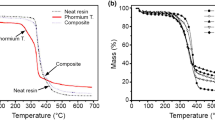Abstract
Three series of epoxy composite systems were fabricated and tested varying the filler type and content. An epoxy resin was employed as the matrix, while boron carbide (B4C), titanium carbide (TiC), and graphite (C) microparticles were the reinforcing phases. The behavior of these systems under the influence of time-varying mechanical stress was investigated via dynamic mechanical analysis (DMA), while their thermal response was examined by means of differential scanning calorimetry (DSC). Furthermore, systems’ morphology was investigated via scanning electron microscopy, whereas their dielectric properties were examined using broadband dielectric spectroscopy. Storage modulus, loss tangent, dielectric permittivity, and electrical conductivity were studied with parameters filler type, content, and temperature. Glass transition temperature was also determined using DMA and DSC tests. The present work examines the reinforcing ability of the employed fillers, upon the dynamic mechanical properties as well as on the electrical properties and the energy storing ability of their epoxy composites, which have been prepared under identical filler loadings and fabrication conditions. Moreover, the optimum thermomechanical or electrical performance is determined as a function of the reinforcing phase type and content.








Similar content being viewed by others
References
Raptis CG, Patsidis A, Psarras GC. Electrical response and functionality of polymer matrix-titanium carbide composites. Exp Polym Lett. 2010;4:234–43.
Saba N, Tahir P, Jawaid M. A review on potentiality of nano filler/natural fiber filled polymer hybrid composites. Polymers. 2014;6:2247–73.
Tsikriteas ZM, Manika GC, Patsidis AC, Psarras GC. Probing the multifunctional behaviour of barium zirconate/barium titanate/epoxy resin hybrid nanodielectrics. J Therm Anal Calorim. 2020. https://doi.org/10.1007/s10973-020-09855-w.
Trompeta AF, Koumoulos EP, Stavropoulos SG, Velmachos TG, Psarras GC, Charitidis CA. Assessing the critical multifunctionality threshold for optimal electrical, thermal, and nanomechanical properties of carbon nanotubes/epoxy nanocomposites for aerospace applications. Aerospace. 2019;6:7.
Hull D. An introduction to composite materials. New York: Cambridge University Press; 1981.
Park SJ, Seo MK. Types of composites. Interface Sci Technol. 2011;18:501–629.
Konopka K, Biedunkiewicz A, Boczkowska A, Rosłaniec Z, Kurzydłowski KJ. Polymer matrix composites with particles of TiC obtained by a sol–gel method. Solid State Phenom. 2005;106:141–4.
Stavropoulos SG, Sanida A, Psarras GC. A comparative study on the electrical properties of different forms of carbon allotropes—epoxy nanocomposites. Exp Polym Lett. 2020;14:477–90.
Thomas P, Ashokbabu A, Vaish R. Structural, thermal and dielectric properties and thermal degradation kinetics of nylon 11/CaCu3Ti4O12 (CCTO) nanocomposites. J Therm Anal Calorim. 2019;141:1123–35.
Raj CR, Suresh S, Bhavsar RR, Singh VK. Recent developments in thermo-physical property enhancement and applications of solid solid phase change materials. J Therm Anal Calorim. 2020;139:3023–49.
Konstantinou AC, Patsidis AC, Psarras GC. Boron nitride/epoxy resin nanocomposites: development, characterization and functionality. J Therm Anal Calorim. 2020. https://doi.org/10.1007/s10973-020-09933-z.
Friedrich K, Breuer U. Multifunctionality of polymer composites. Oxford: Elsevier; 2015.
Krawczak P. Polymer composites: evolve towards multifunctionality or perish. Exp Polym Lett. 2019;13:771.
Domnich V, Reynaud S, Haber RA, Chhowalla M. Boron carbide: structure, properties, and stability under stress. J Am Ceram Soc. 2011;94:3605–28.
Patsidis AC, Kalaitzidou K, Anastassopoulos DL, Vradis AA, Psarras GC. Graphite nanoplatelets and/or barium titanate/polymer nanocomposites: fabrication, thermomechanical properties, dielectric response and energy storage. J Chin Adv Mater Soc. 2014;2:207–21.
Sanida A, Stavropoulos SG, Speliotis Th, Psarras GC. Development, characterization, energy storage and interface dielectric properties in SrFe12O19/epoxy nanocomposite. Polymer. 2017;120:73–81.
Patsidis AC, Kalaitzidou K, Psarras GC. Graphite nanoplatelets/polymer nanocomposites: thermomechanical, dielectric, and functional behavior. J Therm Anal Calorim. 2014;116:41–9.
Vryonis O, Anastassopoulos DL, Vradis AA, Psarras GC. Dielectric response and molecular dynamics in epoxy-BaSrTiO3 nanocomposites: effect of nanofiller loading. Polymer. 2016;95:82–90.
Psarras GC. Conductivity and dielectric characterization of polymer nanocomposites. In: Tjong SC, Mai YW, editors. Physical properties and applications of polymer nanocomposites. Cambridge: Woodhead Publishing; 2010. p. 31–69.
Jonscher AK. Universal relaxation law. London: Chelsea Dielectrics Press; 1992.
Ioannou G, Patsidis A, Psarras GC. Dielectric and functional properties of polymer matrix/ZnO/BaTiO3 hybrid composites. Compos Part Appl Sci Manuf. 2011;42:104–10.
Patsidis AC, Kalaitzidou K, Psarras GC. Dielectric response, functionality and energy storage in epoxy nanocomposites: barium titanate vs exfoliated graphite nanoplatelets. Mater Chem and Phys. 2012;135:798–805.
Koufakis E, Mathioudakis GN, Patsidis AC, Psarras GC. ZnTiO3/epoxy resin nanocomposites: development, dielectric behavior and functionality. Polym Test. 2019;77:105870.
Mathioudakis GN, Patsidis AC, Psarras GC. Dynamic electrical thermal analysis on zinc oxide/epoxy resin nanodielectrics. J Therm Anal Calorim. 2014;116:27–33.
Author information
Authors and Affiliations
Corresponding author
Additional information
Publisher's Note
Springer Nature remains neutral with regard to jurisdictional claims in published maps and institutional affiliations.
Rights and permissions
About this article
Cite this article
Gioti, S., Stavropoulos, S.G., Sanida, A. et al. A comparative study on the thermomechanical and electrical properties of carbide/or graphite/epoxy-reinforced composites. J Therm Anal Calorim 142, 1649–1657 (2020). https://doi.org/10.1007/s10973-020-10257-1
Received:
Accepted:
Published:
Issue Date:
DOI: https://doi.org/10.1007/s10973-020-10257-1




